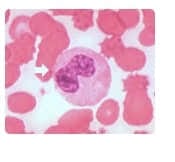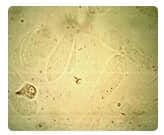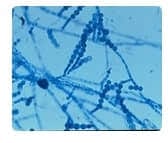Exam Details
Exam Code
:ASCP-MLTExam Name
:MEDICAL LABORATORY TECHNICIAN - MLT(ASCP)Certification
:ASCP CertificationsVendor
:ASCPTotal Questions
:572 Q&AsLast Updated
:Apr 15, 2025
ASCP ASCP Certifications ASCP-MLT Questions & Answers
-
Question 391:
First, the RBC indices must be calculated. The MCV ((Hct/RBC) x 10) = 71 fL. Since the reference range for the MCV is 80-100 fL, this anemia would be classified as microcytic. The MCH ((Hgb/RBC) x 10) = 19.3 pg. Since the reference range for the MCH is 27-33 pg, this would be considered hypochromic. Finally, the MCHC ((Hgb/Hct) X 100) = 27%. Since the normal range for the MCHC is 33%-36%, this would indicate hypochromia which correlates with the MCH findings. The correct answer is therefore microcytic, hypochromic anemia.
A patient is admitted to the emergency room with lethargy and pallor. The CBC results are as follows:
RBC = 4.1 x 1012/L
Hemoglobin = 7.9 g/cL
Hematocrit = 29%
How would you classify this anemia?
A. microcytic, hypochromic
B. normocytic, normochromic
C. macrocytic, normochromic
D. microcytic, hyperchromic
-
Question 392:
What additional fraction would be seen if plasma rather than serum was subjected to electrophoresis:
A. Alpha-1 antitrypsin
B. Alpha-2 macroglobulin
C. Fibrinogen
D. Gamma globulins
-
Question 393:
Since hemoglobin is measured spectrophotometrically on hematology analzyers, interference from lipemia or icteric specimens can lead to decreased light detected and measured through the sample and therefore inaccurate hemoglobin results occur. On an electronic cell counter, hemoglobin determination may be falsely elevated caused by the presence of:
A. Lipemic or icteric plasma
B. Leukocytopenia or Leukocytosis
C. Rouleaux or agglutinated RBCs
D. Anemia or Polycythemia
-
Question 394:
As maturation continues in the granulocytic series the nucleus of the metamyelocyte becomes kidney or bean shaped.
Identify the cell in this illustration indicated by the arrow:

A. Monocyte
B. Myeloblast
C. Promonocyte
D. Metamyelocyte
-
Question 395:
A laboratory scientist is preparing a chemical reagent for testing and accidentally spills the chemical on the counter. How is this contamination taken care of?
A. The laboratory scientist must consult with their supervisor on the proper way to clean the spill.
B. The laboratory scientist can ask a co-worker to assist in the cleanup of the spill.
C. The laboratory scientist can just wipe the spill with saline and throw the towel in the garbage.
D. The laboratory scientist needs to consult with the safety data sheets (SDSs).
-
Question 396:
Cryoglobulin testing can be used to:
A. Screen for rheumatoid arthritis
B. Screen for systemic lupus erythematosus (SLE)
C. Help diagnose Raynaud's syndrome
D. Diagnose syphilis
-
Question 397:
Parathyroid hormone regulates serum calcium by acting on bone, kidney, and intestines while regulating phosphate by stimulating the intestines and the kidneys, enhancing absorption and reabsorption respectively.
Chem
The parathyroid hormone is important in the regulation of:
A. iodine and bromine
B. calcium and phosphate
C. acid and alkaline phosphatase
D. zinc and magnesium
-
Question 398:
1 SD = 68.3%, 2 SD = 95.5%, 3 SD = 99.7
As defined by a Gaussian distribution curve, what percentage of values would be expected to fall within two standard deviations of the mean:

A. 75%
B. 85%
C. 95%
D. 100%
-
Question 399:
Which of the following cardiac biomarkers rises within 30 minutes - 4 hours after chest pain, peaks in 2 - 12 hours, and is usually normal within 24 - 36 hours.
A. Cardiac troponins
B. CK-MB
C. Myoglobin
-
Question 400:
The microscopic features shown here represent Scopulariopsis species. In most instances, particularly if a patient does not have underlying immunologic or hematologic disease, Scopulariopsis species should be considered a contaminant
when recovered from a sputum specimen. However, if there is clinical or X-ray evidence of mycotic pulmonary infection, additional daily induced sputum specimens should be obtained.
If Scopulariopsis species or any other hyaline mold is recovered from two or more successive specimens, its potential as a pathogenic agent should be considered. Scopulariopsis species have been reported as the agents of pulmonary
fungus ball infections in patients with preexistent cavities and as a cause of pneumonia in patients with leukemia.
Invasive pulmonary disease by this agent has not been reported.
The fungus illustrated in this photomicrograph was recovered from an induced sputum specimen from a 74 year old man with chronic obstructive pulmonary disease. This isolate is most likely:

A. The cause of chronic bronchitis
B. The cause of invasive pulmonary disease
C. The cause of allergic bronchopulmonary disease
D. A contaminant
Related Exams:
Tips on How to Prepare for the Exams
Nowadays, the certification exams become more and more important and required by more and more enterprises when applying for a job. But how to prepare for the exam effectively? How to prepare for the exam in a short time with less efforts? How to get a ideal result and how to find the most reliable resources? Here on Vcedump.com, you will find all the answers. Vcedump.com provide not only ASCP exam questions, answers and explanations but also complete assistance on your exam preparation and certification application. If you are confused on your ASCP-MLT exam preparations and ASCP certification application, do not hesitate to visit our Vcedump.com to find your solutions here.